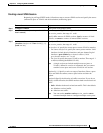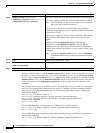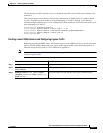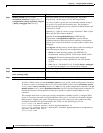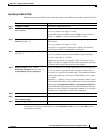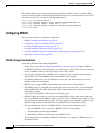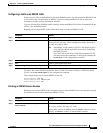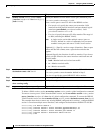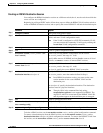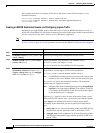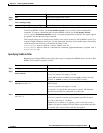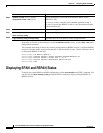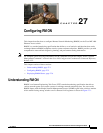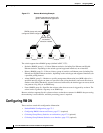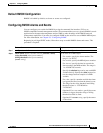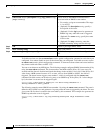
26-19
Cisco ME 3400 Ethernet Access Switch Software Configuration Guide
OL-9639-06
Chapter 26 Configuring SPAN and RSPAN
Configuring SPAN and RSPAN
Creating an RSPAN Destination Session
You configure the RSPAN destination session on a different switch; that is, not the switch on which the
source session was configured.
Beginning in privileged EXEC mode, follow these steps to define the RSPAN VLAN on that switch, to
create an RSPAN destination session, and to specify the source RSPAN VLAN and the destination port:
To delete a SPAN session, use the no monitor session session_number global configuration command.
To remove a destination port from the SPAN session, use the no monitor session session_number
destination interface interface-id global configuration command. To remove the RSPAN VLAN from
the session, use the no monitor session session_number source remote vlan vlan-id.
Command Purpose
Step 1
configure terminal Enter global configuration mode.
Step 2
vlan vlan-id Enter the VLAN ID of the RSPAN VLAN created from the source
switch, and enter VLAN configuration mode.
Note If the VLAN is configured as a UNI-ENI community VLAN,
you must remove the community VLAN type by entering the
no uni-vlan VLAN configuration command.
Step 3
remote-span Identify the VLAN as the RSPAN VLAN.
Step 4
exit Return to global configuration mode.
Step 5
no monitor session {session_number | all |
local | remote}
Remove any existing RSPAN configuration for the session.
For session_number, the range is 1 to 66.
Specify all to remove all RSPAN sessions, local to remove all local
sessions, or remote to remove all remote SPAN sessions.
Step 6
monitor session session_number source
remote vlan vlan-id
Specify the RSPAN session and the source RSPAN VLAN.
For session_number, the range is 1 to 66.
For vlan-id, specify the source RSPAN VLAN to monitor.
Step 7
monitor session session_number
destination interface interface-id
Specify the RSPAN session and the destination interface.
For session_number, enter the number defined in Step 6.
Note In an RSPAN destination session, you must use the same
session number for the source RSPAN VLAN and the
destination port.
For interface-id, specify the destination interface. The destination
interface must be a physical interface.
Note Though visible in the command-line help string,
encapsulation replicate is not supported for RSPAN. The
original VLAN ID is overwritten by the RSPAN VLAN ID,
and all packets appear on the destination port as untagged.
Step 8
end Return to privileged EXEC mode.
Step 9
show monitor [session session_number]
show running-config
Verify the configuration.
Step 10
copy running-config startup-config (Optional) Save the configuration in the configuration file.



